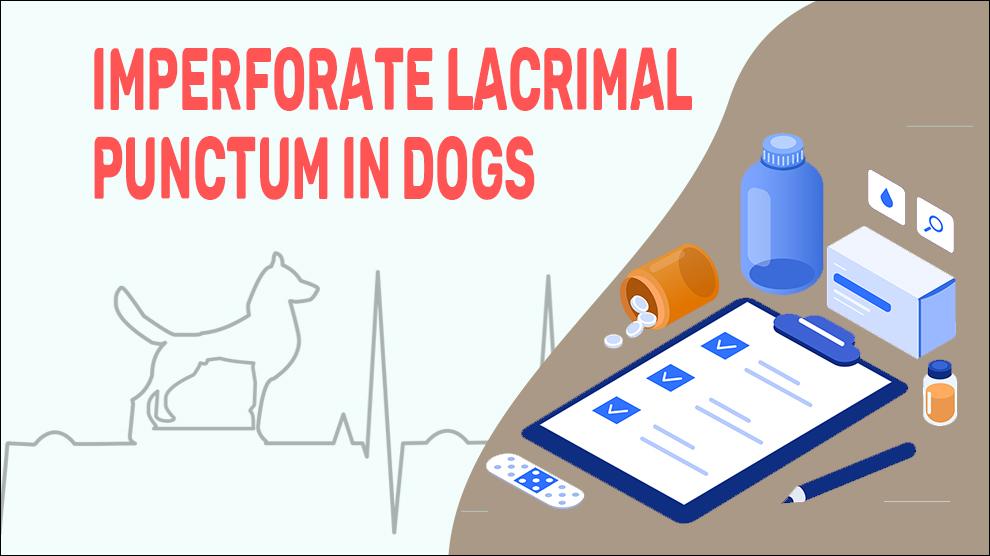Imperforate lacrimal punctum (punctal atresia) is a hereditary anomaly in dogs in which the tear duct (nasolacrimal duct) can become obstructed or blocked in the conjunctiva, causing epiphora resulting in rust-colored stains on the eye corner or face.
Congenital absence of lacrimal puncta was first recorded by Zehender in 1867.
The nasolacrimal duct in dogs has two small openings in the eyelids ( lacrimal puncta), the inferior and the superior.
This disorder can affect one or both of these punctas. The upper (superior) lacrimal puncta are symptomatic. The most commonly affected are the lower nasolacrimal duct and obstruction of the lower duct results in dramatic epiphora.
Symptoms Of Imperforate Lacrimal Punctum
- Nasolacrimal duct obstruction
- Epiphora (Tearing Eyes)
- mucopurulent discharge
- Rust-colored stains (on the eye corner or down the face)
- Blepharospasm (Excessive blinking)
- Rubbing or scratching eye
- Swollen eye
- variable conjunctival hyperemia
Treatment Options For Imperforate Lacrimal Punctum
Discuss the best treatment option with your veterinarian or canine ophthalmologist.
Many times, they will suggest surgery to open the lacrimal punctum.
Antibiotic medications (Metronidazole, Enrofloxacin etc) will be prescribed to reduce the risk of infection after a surgical procedure.
Antibacterial medications and Anti-inflammatory medications may also be prescribed.
Make sure to follow all dosage instructions on medications prescribed.
An Elizabethan collar may be required for your dog to prevent self-trauma.
Home Remedies For Imperforate Lacrimal Punctum
Check with your veterinarian or canine ophthalmologist for the post surgical eye checks, usually once a month to ensure that the lacrimal punctum is still open and to check for any infection.
Until the post operative recovery period is over, do not allow your dogs to play outdoors. This will reduce the risk of debris getting into the eye and injuring the surgical site.
Control your dog from aggravating their eyes (use e-collar)
Prevention Of Imperforate Lacrimal Punctum
The imperforate lacrimal punctum diagnosis is performed by flushing out the nasolacrimal (tear) duct to establish if there is a blockage. If any blockage is found out, the next step is to see what causes the excessive tearing (If the imperforate punctum is blocked or not)
When there are no blockages, more tests will be done (such as a bacterial culture test) to find out any underlying bacterial infection.
The Jones test: Also called lacrimal scintigraphy, this is a noninvasive test used to find Nasolacrimal duct obstruction. Your veterinarian sprays a drop of 2% fluorescein with a topical anesthetic and decongestant (e.g., 4% cocaine) in the eyes; within 5-10 minutes of administration, the dye is expected to travel down the nasolacrimal duct and should be retrieved at the nasal opening. If the dye does not appear in the nasal cavity, a functional nasolacrimal duct block may be present.
Affected Breeds Of Imperforate Lacrimal Punctum
American Cocker Spaniel, Bedlington Terrier, Golden Retriever, Poodle, Samoyed
Additional Facts For Imperforate Lacrimal Punctum
Causes
Canine imperforate lacrimal punctum is an inherited disorder. When the lacrimal punctum in the tear duct becomes blocked, the tears that lubricate the eye have no place to drain and they overflow and run out of the eye causing tear stains.
Some dogs have congenital blockages to the lacrimal punctum while others are born with very smaller openings that get blocked easily.
Other causes:
- Inflammation or infection (dacryocystitis) within the eye or in lacrimal duct
- Due to foreign materials lodged within the lacrimal duct.
- Scarring from prior infection or trauma
- Compression from a lacrimal canalicular cyst (canaliculops)
- Neoplasm
- Bony malformation
When To See A Vet
Time to visit the vet clinic for an eye examination, if you notice any of the following:
- When you see your dog has excessive tearing (epiphora) with pawing or squinting of the eyes
- Your dog eyes look red and feeling of discomfort
- Increased tear staining or change in the appearance of tear staining
Food Suggestions For Imperforate Lacrimal Punctum
- Low-carb dog food/ Whole, unprocessed foods
- Lean meat protein
- Vitamin C and bioflavonoids: brussel sprouts, spinach, broccoli, kale, pineapple, papaya, and strawberries etc
- Coq10 foods-organ meats, muscle meats( beef, pork), legumes, nuts, seeds etc
- Omega Fatty Acids- salmon, tuna, cod, halibut, trout, herring fish
- Blueberries, broccoli, carrots
- Sweet potato, pumpkin, tomato
- Leafy green vegetables (lettuce, spinach, salad greens, parsley, collard greens )
- Intake of dietary nitrates- mainly from green leafy vegetables
Conclusion
When left untreated, nasolacrimal duct obstruction will cause unsightly issues with tear staining with excessive watering of the eyes. Dogs also have an increased likelihood of bacterial infection and foul odour in face. The prognosis for resolution of Imperforate lacrimal punctum by one or more surgical procedures is quite good.

















